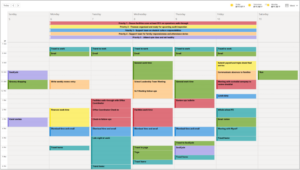I’ve been spending a lot of time with Charlotte-Mecklenberg Schools these days (see here, here, and here), and I keep learning more and more! So of course, when I spied this District Meeting Schedule on Talla R.’s workspace during a recent session, I had to find out how it came to be!

District Meeting Schedule
Talla reports, “When I entered into my role as Executive Director of Strategy, there was a lot of groaning about our meetings. I embarked on a journey to improve them by clearly communicating their schedule and purpose.” Drooling already!

District Meeting Summary
Laying this all out in advance helped people see how much time they have together and proactively think through how to best spend that time. She now gets asked for this plan earlier and earlier each year!
I wanted to know what all of this articulation and frankly, WORK, is getting the district? And I loved Talla’s reply:
“It forces us to think way in advance about what our big priorities are so we can ensure we have dedicated meeting time to focus on those priorities. For example, last year when we were creating our schedule we knew Student Assignment Review was going to be a big priority. We set aside a chunk of every other executive staff meeting to focus on this work. If we had not thought ahead about this we probably would have added many ad hoc meetings to the calendar, or we might not have had our most senior leaders fully engaged in the work.”
Talla noted three other benefits:
- It protects our individual time so we’re not always in meetings – we commit to the meeting schedule and use our time together wisely. The question is always “What upcoming meeting does this fit into?” rather than, “Let’s schedule another meeting to discuss.”
- It gives meeting owners the option to say “no” when they get agenda item requests that fall outside the stated purpose of the meetings. This was much harder for them to do when the purpose wasn’t stated so clearly.
- It increased the level of expectations for our meetings. Completing this yearly process gives us the time and space to really reflect on the quality of our meetings – so it has become a tool for continuous improvement. We keep getting better and better about using meetings for focused priorities. This also created a nice opportunity to document and provide structure to other parts of our meetings – like roles and responsibilities, facilitation, and norms.
And here’s Talla’s advice on creating a Meeting Matrix in another district, CMO, or nonprofit settings:
- Designate a senior person that has access to decision makers to own this calendar. It’s easy to think an assistant could do this job – and they can help facilitate some logisitics (send out invites, reserve rooms, etc.) – but to start you really need someone that can bring together multiple viewpoints and influence senior leaders.
- Be thoughtful about scope – which meetings do and do not belong here? We limit ours to any that all cabinet, executive staff, or leadership team members need to attend. This document is not intended to be a comprehensive master calendar.
- Honor the calendar. If you start adding a bunch of meetings on top of what’s on here (or letting them run way over time), people won’t respect the calendar in the future.
Want to know more about how on earth Talla orchestrates all of this across a huge school district?! Or what a Meeting Manager is? Stay tuned for her process, as well as her roles and responsibilities doc!


